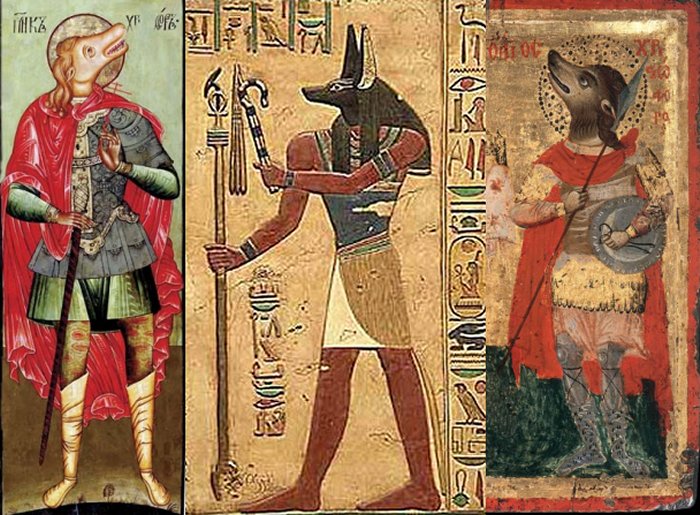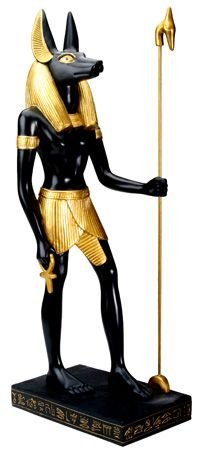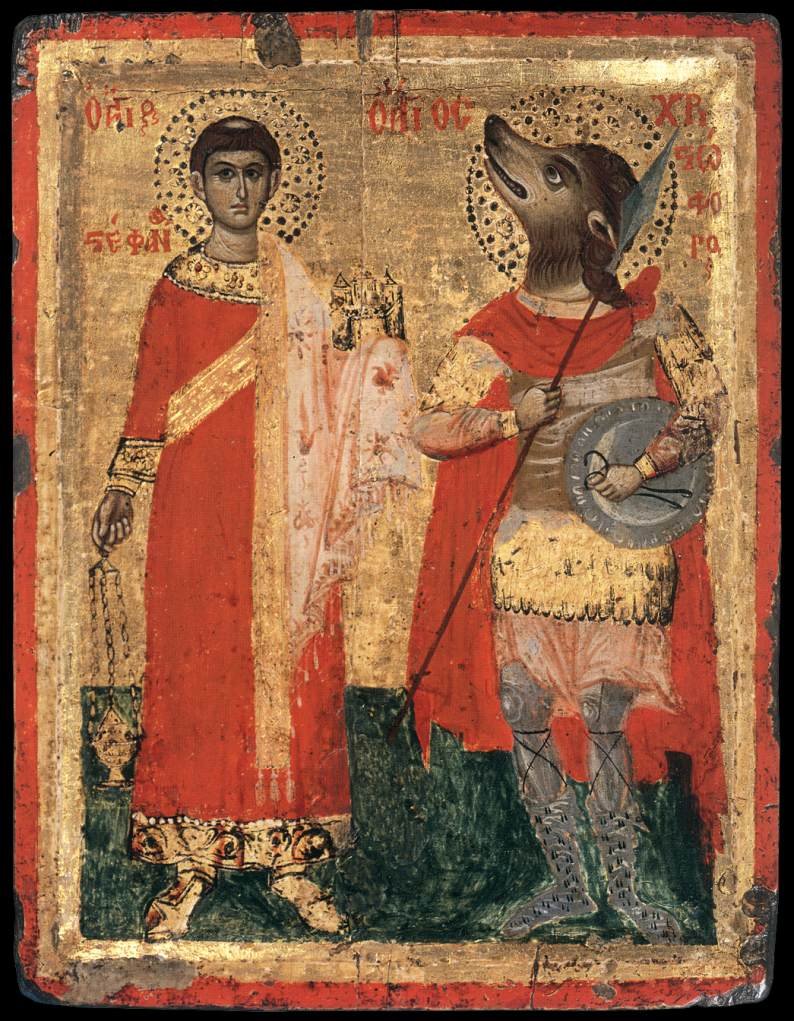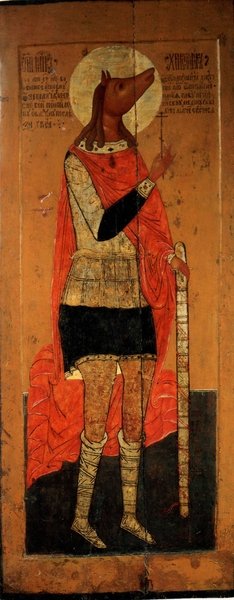Mysterious Dog-Headed St. Christopher Reminds Of The Egyptian Jackal God Anubis
Ellen Lloyd - AncientPages.com - The lives of many saints are often shrouded in mystery. St. Christopher who died as a martyr is one of the most venerated Christian saints.
Yet, there is a lot we don’t know about the man who died as a martyr. The truth is that we don’t even know if he existed in the first place.
What is even more intriguing is that in the Byzantine Museum in Athens, Greece, we come across something remarkable, something that could shed light on his identity. Here we find an icon of a Dog-Headed St. Christopher. Why is St. Christopher depicted with a dog head?
What Does Jackal God Anubis Have In Common With St. Christopher?
It’s curious because the holy Christian reminds of the Jackal God Anubis, one of the immortal Egyptian gods. In the underworld, Anubis was the protector of the dead bodies. His widely known epithet the ‘Lord of the sacred land’ or ‘Lord of the pure land’ emphasized his supreme power over desert areas covered with necropolises. Also his title ‘He who is upon his sacred mountain’ relates to the jackal god watching over the burials of the dead from the heights of the desert cliffs.
In the Pyramid Texts, there is a reference to ‘the Jackal, the Governor of the Bows’, more exactly, nine bows – nine figures depicted as literal bows, probably representing captives – the enemies of Egypt.
According to the Catholic Church, St. Christopher is the patron of bachelors, transportation, traveling, storms, epilepsy, gardeners, holy death, and toothache.
Historians, artists, and scholars have long debated why St. Christopher is depicted with a dog’s head. St. Christopher is usually depicted as a giant man, with a child on his shoulder and a staff in one hand.
Some scholars suggest his depiction in Eastern Orthodox icons with a dog head is simply a mistake that resulted from a misinterpretation of the Latin term Cananeus (Canaanite) to read canineus (canine).
The Mysterious Dog-Headed Race
Ancient legends mention a mysterious dog-headed race that once lived among men. According to the Orthodox Arts Journal, “dog-headed men appear in the story of St-Mercurios, a warrior saint whose father was eaten by two dog-headed men later converted by St-Mercurios.
These dog-headed men’s savage nature could be unleashed by St-Mercurios on the enemies of the Roman empire in a way analogous to how Romans and later Christians used Barbarians in their own wars.”
17th century icon of St. Stephen and St. Christopher
In Medieval times it was commonly accepted at the time that there were several types of races, the Cynocephalus, or dog-headed people, being one of many believed to populate the world. Walter of Speyer, a German poet and writer portrayed St. Christopher as a giant of a cynocephalic species in the land of the Chananeans who ate human flesh and barked.
The use of dog-headed men in iconography is not limited to the icon of St-Christopher. These enigmatic beings appear also in images of Pentecost, prominently in Armenian manuscripts, but also in Western images.
Did St. Christopher Exist?
Tracing St. Christopher’s life and death requires a lot of research. We don’t know his true identity. Historical evidence is based on legends that suggest this intriguing man lived during the Christian persecutions of the Roman emperor Decius (249 to 251), and that he was captured and martyred by the governor of Antioch.
Historian David Woods has proposed that St. Christopher's remains were possibly taken to Alexandria by Peter of Attalia where he may have become identified with the Egyptian martyr Saint Menas.
The Orthodox icon of St. Christopher presents him as a warrior cynocephalus, a dog-headed man from Lycea. Sometimes he is also of gigantic size as well. According to his tradition, he was a Roman soldier taken from the far end of the world who converted and was martyred by an Emperor.
St. Christopher died because he refused to sacrifice to the pagan gods. The king ordered him to be killed. Various attempts failed, but finally, Christopher was beheaded. Before his death, St. Christopher had managed to convert thousands of people to Christianity. His feast is on July 25 every year.
Written by Ellen Lloyd – AncientPages.com
Copyright © AncientPages.com & Ellen Lloyd All rights reserved. This material may not be published, broadcast, rewritten or redistributed in whole or part without the express written permission of AncientPages.com and Ellen Lloyd
Expand for referencesMore From Ancient Pages
-
 How Human Ancestors Used Fire – New Methods Give Answers
Archaeology | Nov 2, 2022
How Human Ancestors Used Fire – New Methods Give Answers
Archaeology | Nov 2, 2022 -
 Catherine De Medici – Queen Of France Supported Nostradamus, Was Suspected Of Poisoning And Blamed For Horrible Massacre
Featured Stories | Dec 17, 2018
Catherine De Medici – Queen Of France Supported Nostradamus, Was Suspected Of Poisoning And Blamed For Horrible Massacre
Featured Stories | Dec 17, 2018 -
 Beautiful Zeugma-Like Mosaics Unearthed In Sinop Province, Northern Turkey
Archaeology | Oct 17, 2020
Beautiful Zeugma-Like Mosaics Unearthed In Sinop Province, Northern Turkey
Archaeology | Oct 17, 2020 -
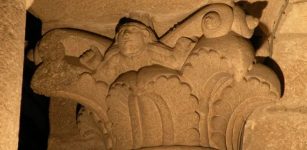 Hidden Carving Of Stonemason Never Meant To Be Seen Discovered In Cathedral Santiago De Compostela
News | Nov 2, 2020
Hidden Carving Of Stonemason Never Meant To Be Seen Discovered In Cathedral Santiago De Compostela
News | Nov 2, 2020 -
 Ancient Native Americans’ Encounter With The Star People – An Otherworldly Rescue?
Featured Stories | Jul 20, 2021
Ancient Native Americans’ Encounter With The Star People – An Otherworldly Rescue?
Featured Stories | Jul 20, 2021 -
 Strange Tale Of Demonic Possession And Exorcism In 17th-Century New France – What Happened?
Featured Stories | Oct 21, 2022
Strange Tale Of Demonic Possession And Exorcism In 17th-Century New France – What Happened?
Featured Stories | Oct 21, 2022 -
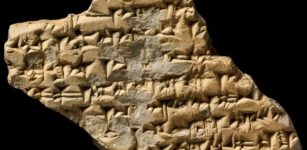 Artificial Intelligence And Clay Tablets: Not Yet A Perfect Match
Scripts, Paintings & Inscriptions | Oct 12, 2023
Artificial Intelligence And Clay Tablets: Not Yet A Perfect Match
Scripts, Paintings & Inscriptions | Oct 12, 2023 -
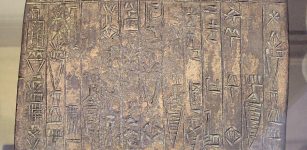 Ancient City Of Urkesh – Home Of Kumarbi – The Foremost Son Of Anu
Featured Stories | Aug 24, 2020
Ancient City Of Urkesh – Home Of Kumarbi – The Foremost Son Of Anu
Featured Stories | Aug 24, 2020 -
 Unusual Object With Crosses And Enigmatic Runes Discovered In Sweden
Archaeology | May 16, 2018
Unusual Object With Crosses And Enigmatic Runes Discovered In Sweden
Archaeology | May 16, 2018 -
 Mysterious Tiny Pre-Viking Gold Foil Figures Baffle Scientists
Archaeology | Nov 5, 2019
Mysterious Tiny Pre-Viking Gold Foil Figures Baffle Scientists
Archaeology | Nov 5, 2019 -
 Mysterious Book That ‘Killed’ – Are Written Or Spoken Words Powerful Enough To Take Control Over Our Actions?
Featured Stories | Nov 21, 2022
Mysterious Book That ‘Killed’ – Are Written Or Spoken Words Powerful Enough To Take Control Over Our Actions?
Featured Stories | Nov 21, 2022 -
 ‘Impossible’ Ancient Traces Of Humans – No, We Are Not The First
Artifacts | May 16, 2020
‘Impossible’ Ancient Traces Of Humans – No, We Are Not The First
Artifacts | May 16, 2020 -
 On This Day In History: ‘Devil’s Footprints’ Appeared In Devon, England – Feb 8/9, 1855
News | Feb 8, 2017
On This Day In History: ‘Devil’s Footprints’ Appeared In Devon, England – Feb 8/9, 1855
News | Feb 8, 2017 -
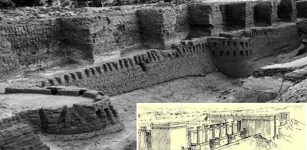 Massive Fortress Buhen In Ancient Capital Of Egyptian Nubia
Archaeology | Mar 20, 2017
Massive Fortress Buhen In Ancient Capital Of Egyptian Nubia
Archaeology | Mar 20, 2017 -
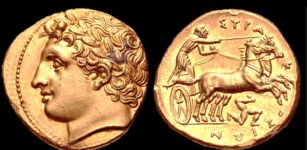 Agathocles Of Syracuse: Sicilian Ruler Who Committed Numerous Crimes Saved And Extended Sovereignty Of Sicily
Featured Stories | Jul 26, 2019
Agathocles Of Syracuse: Sicilian Ruler Who Committed Numerous Crimes Saved And Extended Sovereignty Of Sicily
Featured Stories | Jul 26, 2019 -
 On This Day In History: Albertus Magnus – Medieval Person Of Great Historical Importance Died – On Nov 15, 1280
News | Nov 15, 2016
On This Day In History: Albertus Magnus – Medieval Person Of Great Historical Importance Died – On Nov 15, 1280
News | Nov 15, 2016 -
 Dismantled Ancient Stone Circle In West Wales Was Used To Rebuilt As Stonehenge
Archaeology | Feb 13, 2021
Dismantled Ancient Stone Circle In West Wales Was Used To Rebuilt As Stonehenge
Archaeology | Feb 13, 2021 -
 Little Known Neanderthal Technology Examined – Turning Bones Into Tools
Archaeology | Jun 19, 2023
Little Known Neanderthal Technology Examined – Turning Bones Into Tools
Archaeology | Jun 19, 2023 -
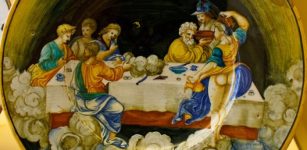 Amrita: Potion Of Immortality Consumed By Gods To Make Them Strong And Immortal
Featured Stories | Apr 5, 2019
Amrita: Potion Of Immortality Consumed By Gods To Make Them Strong And Immortal
Featured Stories | Apr 5, 2019 -
 Edfu Texts Reveal Secrets Of Predynastic Egypt And Zep Tepi
Featured Stories | May 27, 2021
Edfu Texts Reveal Secrets Of Predynastic Egypt And Zep Tepi
Featured Stories | May 27, 2021

